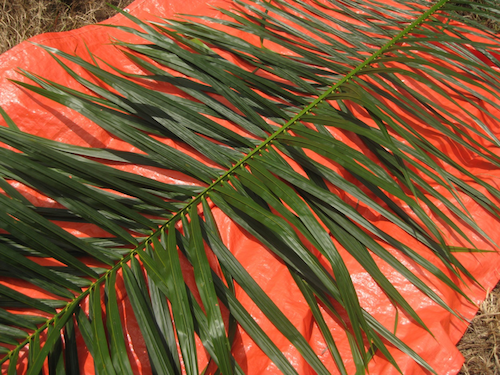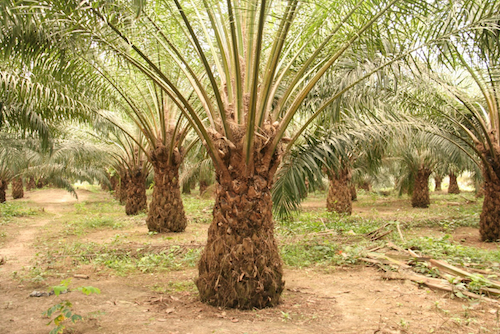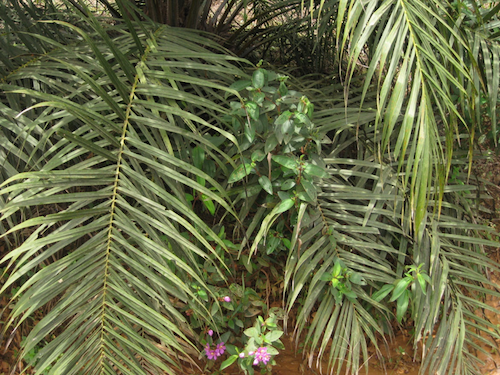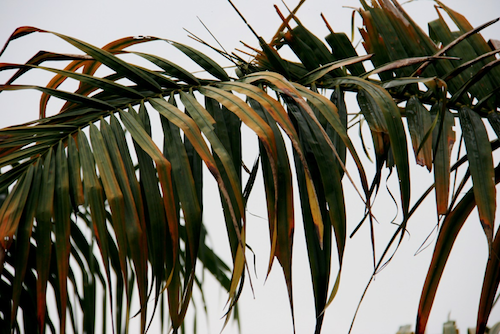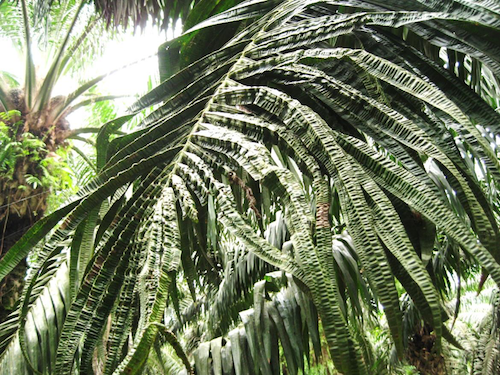Budidaya Kelapa Sawit Berkelanjutan / Gejala defisiensi hara
Download: Module 4: Fertiliser Application
Contents
Background
A healthy oil palm leaf is dark green, strong and flexible. In fully mature palms (more than 10 years after planting) the leaf is 5—8 m long and has leaflets up to 1.20 m long (see Figure 6).
Nutrient deficiency symptoms in oil palms can occur as a result of the following:
- Not enough nutrients are applied;
- Nutrients are applied in the wrong way;
- Nutrients do not reach the palms because of the conditions in the plantation (e.g. waterlogging, soil erosion, or competition with weeds).
What follows is a description of the key types of nutrient deficiencies and their symptoms in oil palms.
Nitrogen (N) deficiency
- Leaflets turn an overall light green or yellow colour, starting in the older leaves (see Figure 7).
- In severe cases, leaflets may curl up and die, starting at the tip and edges.
- Also in severe cases, the rachis and the midribs of the leaflets turn bright yellow or orange 1 , 2 (see Module 3: Plantation Maintenance for an explanation of these terms). This type of yellowing often happens when palms are in low-lying areas or swamps that are flooded during part of the year and have a high water table.
- Weeds under the palms sometimes also show a pale green or yellow colour.
Phosphorus (P) deficiency
- P deficiency does not tend to show up clearly in oil palm leaves although in some cases the leaves may be shorter (‘stunted’) and bunches smaller.
- Trunks have a pyramid-shape (see Figure 8) which is wider at the bottom and much thinner at the top.
- P deficiency can show in the weeds by:
Potassium (K) deficiency
- Yellow or orange spots with irregular shapes appear on the leaves, starting in the older leaves. If the leaves are held up to the sun, the light shines through the spots (see Figure 10).
- Later, the spots turn orange and grow until they fuse together.
- In severe cases, K deficiency shows as an overall yellowing of the older leaves (especially on acid sands or peat soils) giving the appearance of the whole crown turning yellow.
- ‘White stripe’, a straight white line on both sides of the mid-ribs of the leaflet, sometimes is a sign of too much N and not enough K and B 1 , 2 (see Figure 11), although this may also be genetic.
Magnesium (Mg) deficiency
- Leaflets on older leaves that are in direct sunlight get an even olive green to orange/yellow colour, starting at the tip of the leaflet;
- Typically only leaflets in full sunlight turn yellow, but not the shaded leaflets and young leaves (see Figure 12);
- In severe cases, the leaflets become bright yellow and die, starting at the edge and tip of the leaflets 1 , 2.
Boron (B) deficiency
- Leaves are crinkled and dark green (see Figure 13);
- Leaflet tips sometimes fold sharply (see Figure 14);
- New fronds get shorter and shorter so the top of the palm crown appears flattened 2;
- Sometimes the tip of the leaf is completely missing (see Figure 15).
Copper and zinc deficiency
Copper and zinc deficiencies are to be expected in peat soils only. It is very rare to find deficiencies in mineral soils.
- The youngest leaves become yellow at the tips of the leaflets, but the mid-ribs stay green;
- In severe cases, the leaflets die off from the tips inward (see Figure 16);
- New fronds become shorter and shorter.
References
- ↑ 1.0 1.1 1.2 K.J. Goh, R. Hardter, General Oil Palm Nutrition, (2003).
- ↑ 2.0 2.1 2.2 2.3 2.4 I.R. Rankine, T.H. Fairhurst, Field Handbook: Oil Palm Series, Volume 3 – Mature, second ed., Potash & Phosphate Institute (PPI), Singapore, 1999.
Acknowledgements
The material from Nutrient deficiency symptoms is sourced from Smallholder Oil Palm Handbook and put together by Lotte Suzanne Woittiez (Wageningen Universit) and Haryono Sadikin, Sri Turhina, Hidayat Dani, Tri Purba Dukan, and Hans Smit (SNV) in August 2016. See Module 4: Fertiliser Application for more information.


